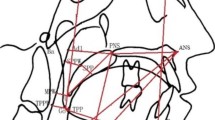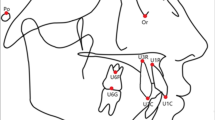Abstract
To analyze the influence of environmental and genetic factors on craniofacial growth and development, especially on the children in the stage of mixed dentition using twin method and to find the sensitive areas to environmental factors, providing the feasible reference for early orthodontic modification. The posterior-anterior and lateral cephalograms of 89 pairs of female twins aged from 6 to 12 years were measured. 183 effective pairs of twins were included using a mixed longitudinal observation manner (110 pairs of monozygotic twins, 73 pairs of dizygotic twins). Twin method was used to measure the longitudinal effects of environmental and genetic factors on the length, the angle and functional areas of craniofacial hard and soft tissues. Statistical analysis was performed using SPSS17.0 software. Paired t test was used to evaluate the statistical significance of differences between samples. The length (L1, L2, L5, L6, L7, L8, L11, L12), the height (SGo, H1, H3, H4, H12, H13, H14, H15, H16, H17, H18, H19), the angle (ANB, NAP, ∠1, ∠2, ∠5, ∠6) and the area (S1,S2) were affected by environmental factors (P < 0.05).The length (L4, L8, L10, L11, L12), the height (NMe,SGo,H2,H3,H4,H5,H6,H7,H8,H9,H10,H11,H18), the angle (∠1, ∠2) and the area (S3, S6) were affected by genetic factors (P < 0.05). Early orthodontic modification could change the anterior–posterior relationship of maxillary and mandible and the depth of craniofacial soft and hard tissues. The change in the depth of lower face was the most obvious. Early orthodontic modification could change the height of hard tissues of posterior face, which faced genetic resistance. There was high genetic resistance in anterior face height which was the most difficult for the change. Genetic resistance in changing the width of maxillary base bone existed as using early orthodontic modification.




Similar content being viewed by others
References
White, L.W.: Early orthodontic intervention. Am. J. Orthod. Dentofacial Orthop. 113(1), 24–28 (1998)
Dugoni, S.A.: Comprehensive mixed dentition treatment. Am. J. Orthod. Dentofacial Orthop. 113(1), 75–84 (1998)
Proffit, W.R.: The timing of early treatment: an overview. Am. J. Orthod. Dentofacial Orthop. 129(4 Suppl), S47–S49 (2006)
O’Brien, K.: Is early treatment for class II malocclusion effective? results from a randomized controlled trial. Am. J. Orthod. Dentofacial Orthop. 129(Suppl 1), S64–S65 (2006)
Ngan, P.: Early treatment of Class III malocclusion: is it worth the burden? Am. J. Orthod. Dentofacial Orthop. 129(4 Suppl), S82–S85 (2006)
Nakata, M.: Twin studies in craniofacial genetic: a review. Acta. Genet. Med. Gemellol. 34(1), 1–14 (1985)
Christian, J.C.: Testing twin means and estimating genetic variance basic methodology for the analysis of quantitative twin data. Acta. Genet. Med. Gemellol. 28(1), 35–40 (1979)
Dudas, M., Sassouni, V.: The hereditary components of mandibular growth, a longitudinal twin study. Angle Orthod. 43(3), 314–322 (1973)
Nakata, M.: Twins and growth of dentofacial structure. Prog. Clin. Biol. Res. 24 Pt C, 205–210 (1978)
Ishikawa, M.: Genetic and racial variations of the three-dimensional Craniofacial morphology: a longitudinal study of North American Caucasian boys. Pediatr. Dent. J. 1(2), 127–136 (1991)
Peng, J., Deng, H., Cao, C.F., et al.: Craniofacial morphology in Chinese female twins: a semi-longitudinal cephalometric study. Eur. J. Orthod. 27(6), 556–561 (2005)
Osborne, R.H., DeGeorge, F.V.: Genetic basis of morphologic variation, pp. 3–68. Harvard University Press, Cambridge (1959)
Peng, J.: Genetic and environmental effects of craniofacial hard tissue morphology in twins of 6-12 years old. Peking University Health Science Center, Beijing (2002)
Coben, S.E.: The sphemo-Oecipital synchondrosis: the missing link between the profession’s concept of craniofacial growth and orthodontic treatment. Am. J. Orthod. Dentofacial Orthop. 114(6), 709–712 (1998)
Coben, S.E.: The biology of Class II treatment. Am. J. Orthod. 59(5), 470–487 (1971)
Sun, S., Li, X., Zhuang, F., et al.: The comparison in clinical application of Teeth pad made from glass ion cement and traditional reed and correcting device in treating the children with anterior crossbites. In: The Oral Cavity Medical Research Magazine, 9(3), 221–225 (2015)
Courant, R.: Variational method for solutions of problems of equilibrium and vibrations. Bull. Am. Math. Soc. 49, 1 (1943)
Thordarson, Arni, Johannsdottir, Berglind: Craniofacial changes in Icelandic children between 6 and 16 years of age-alongitudinal study. Eur. J. Orthod. 28(2), 152–165 (2006)
Lauwcrvns, I., Carels, C.: Vlietinck R The use of twins in dentofacial genetic research. Am. J. Orthod. Dentofac. Orthop. 103(1), 33–38 (1993)
Harris, E.F., Potter, R.H.: Source of bias in heritability studies. Am. J. Orthod. Dentofac. Orthop. 112(3), 17A–21A (1997)
Deng, H.: Children’s oral medicine (Peking University medical textbooks). In: Early Orthodontic Treatment of Mixed Dentition, pp. 218–243. Peking University medical press, Beijing (2005)
Shige, Sun, Xuyan, Li, Futao, Zhuang, et al.: Glass ionomer splint and traditional splint appliance in the treatment of children’s tongue before clinical application of crossbite of oral cavity of [J/CD]. Med. J. 9(3), 221–225 (2015)
Proffit, W.R., Fields, H.W.: Contemporary orthodontics, 4th edn, pp. 27–165. Mosby, St. Louis (2007)
Deng, H.: Pediatric dentist (the teaching materials of Beijing medical university). In: Orthodontic Modification for the Early Stage of Mixed Dentition. Peking University Medical Press, Beijing, pp. 218–243 (2005)
Author information
Authors and Affiliations
Corresponding author
Rights and permissions
About this article
Cite this article
Jing, L., Fangyuan, Z. & Jing, P. The longitudinal analysis of the genetic effects on craniofacial morphology in posterior–anterior and lateral cephalograms of female twins aged from 6 to 12 years. Cluster Comput 22 (Suppl 2), 4957–4969 (2019). https://doi.org/10.1007/s10586-018-2447-x
Received:
Revised:
Accepted:
Published:
Issue Date:
DOI: https://doi.org/10.1007/s10586-018-2447-x




